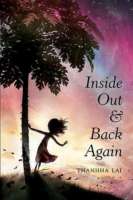
No one would believe me but at times I would choose wartime in Saigon over peacetime in Alabama. For all the ten years of her life, HÀ has only known Saigon: the thrills of its markets, the joy of its traditions, the warmth of her friends close by . . . and the beauty of her very own papaya tree. But now the Vietnam War has reached her home. HÀ and her family are forced to flee as Saigon falls, and they board a ship headed toward hope. In America, HÀ discovers the foreign world of Alabama: the coldness of its strangers, the dullness of its food, the strange shape of its landscape . . . and the strength of her very own family. This is the moving story of one girl’s year of change, dreams, grief, and healing as she journeys from one country to another, one life to the next.
See the review at WOW Review, Volume 4, Issue 3
This book has been included in WOW’s Language and Learning: Children’s and Young Adult Fiction Booklist. For our current list, visit our Booklist page under Resources in the green navigation bar.
- ISBN: 9780061962783
- Author: Lai, Thanhha
- Published: 2011 , HarperCollins
- Themes: bullying, Family, Journey, Refugees, strength, War
- Descriptors: Guam, Intermediate (ages 9-14), Poetry, Realistic Fiction, Vietnam
- No. of pages: 276

Michele:
At the end of the novel the author, Thanhha Lai, poses the question to all, “How much do we know about those around us?” and upon finishing the story she hopes that readers “sit close to someone you love and implore that person to tell and tell and tell their story.” This particular question and wish reminded me of the power of story and the need to stop and listen to others’ stories, in particular those who recently moved to a new place and may be adjusting to a new culture. Many times we make judgments or assumptions about those around us, but don’t take the time to truly listen to and know stories that might help us develop compassion, empathy, and greater understanding of those around us. This story encourages us to do so.
Ha’s story pulled on emotional chords as she had to leave her home and her country, however, her struggle to live in a different culture and a new place was particularly compelling for me. I thought that some of the questions that might be interesting to discuss with students while reading this story might be – Do you have to lose one culture to learn another? How do you maintain cultural identity in a new place? Although I have not had the opportunity to ask children these questions, a few weeks ago I visited an elementary school classroom where the students were listening to the teacher read about Ha and her family’s exodus out of South Vietnam. At that point, the students were not interested in the cultural aspects of the story but were moved by Ha’s personal struggles – her missing father, the bombs, and journeying into the unknown. The teacher also shared that she selected the book because students expressed feelings of anxiety as they related it to current political situations in the world and students anticipated their potential vulnerability to war and the effects it has upon everyone’s lives. She was very encouraged by students’ responses and increased engagement. This experience encouraged her to move outside the regular curriculum so that children may hear and learn from stories beyond their own.
Yoo Kyung:
Thanks, Michele for sharing the students’ response to Hà’s story. It is interesting to hear how they focused on war related themes. I was more drawn to Hà’s pride and her confidence as a Vietnamese child more than the negative side of her experiences that were the consequence of the war. That may look like the “struggle” your students describe, but I do not think it was necessarily a “struggle”. To me it resembled frustration from Hà’s side when she realized that the Alabama community had an agenda for her family hidden within their own righteous“ helping” purpose. Most of all, I found her frustration came the from the pity or discomfort of others around her and her family in Alabama. But,Hà insists, “ No one would believe me but at times I would choose wartime in Saigon over peacetime in Alabama” (p.195). Immigrant characters in other books often feel somewhat “disabled” about being who they are and where they are because of worry that they may be too different from their “American” peers. In Hà’s pride and faith in her family, Vietnamese language, and her home country she finds the agency and strength to cope with the range of differences and even “fear” that emanate from the school and the community in Alabama. Inside Out and Back Again challenges the prevalent social mindset in the U. S. toward global refugees and many Americans’ belief in their English monolingual nation. Hà, while learning English as a second language, delights with pride in her native Vietnamese language. Because of Hà’s confident agency, her relationship with her friends in Alabama also grows stronger. I especially appreciated this book because too many immigrant children in children’s books are presented passively in juxtaposition to their American peers who play “helper” and “rescuer.” Hà and her family actually reach out to community members who have their own uneasy stories to share. Ha’s journey of resilience unfolds in atypical ways with both her immediate family and the local community that becomes her second family.